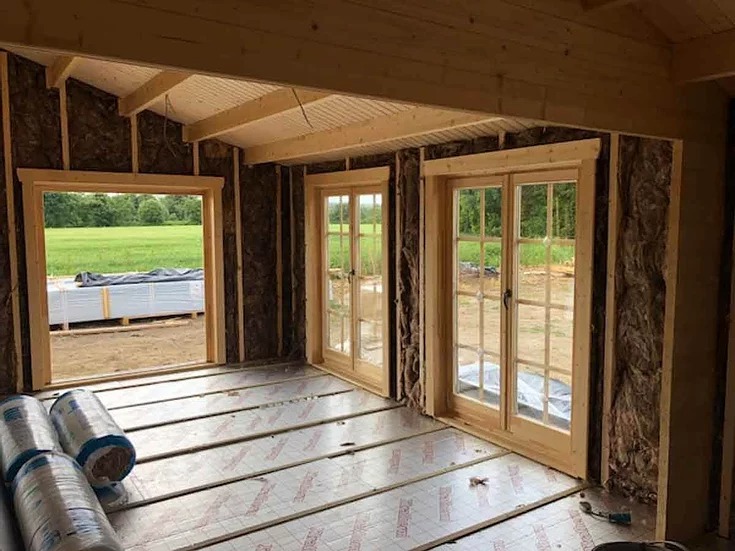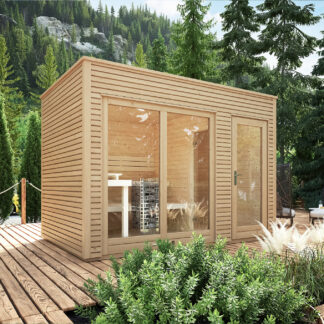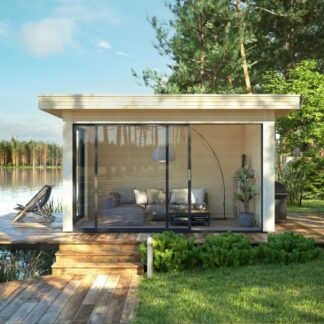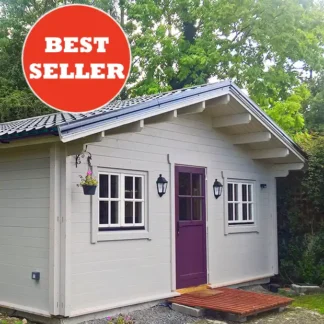
We build a lot of block houses in Ireland. I would say over 90% of all of the people who read this post have lived over 90% of their ives in block or concrete homes. People in Ireland are not familiar with building in timber; we see log homes as exotic dwellings from Scandanavia or Canada or Wyoming. But log cabins are definitely ideal for Ireland’s temperate climate, and there are many benefits to be gained from log cabin living.
How Long Do Log Cabins Last?
“How long will my log cabin last?” is probably THE most common question we are asked by visitors to our log house showrooms. Because nearly all of us were brought up in block or stone houses, It is only natural that we have doubts about quality log cabin timber. But we know that, when we were growing up, every door in the country was made of timber. And they make boats out of timber too! So as long as timber is minded well and treated properly, your log cabin home will last a lifetime.
People think that, due to damp Irish weather, that a log cabin might not last as long here as it would in other, colder countries. But that s a misconception. The damp weather is not detrimental to timber, as long as it is managed. By that I mean that the external coating of the log cabin – what stain you use – is ultimately the most important element in maintaining the longevitiy of your log cabin. Make sure you use the right stain (we recommend Sikkens, from Dulux – read our blog post here: How to Paint Your Log Cabin) And if you need more reassurance regarding log cabins and Irish weather, well, we live in the windiest country in Europe (did you know that!). And that constant wind is the perfect way to keep your log cabin walls dry in damp weather. Take a trip to the Boyle showhouse in a wet and windy day and you can see for yourself how well our log cabins can withstand the ravages of Irish weather. Its really not a problem to them – I would say that the extremes of Scandanavian or CAnadian winters is a lot more detrimental to log cabins.
Some benefits of Timber in buildings

Log cabins have a very low carbon footprint
Because we do not use steel or concrete in construction of log cabins, the carbon footprint of the building is very low. An enormous amount of energy goes into creating concrete and steel, and of course in the generation of this energy, huge amounts of carbon are emitted. So, keep it clean and keep it green, and build a log cabin :-)
The timber for all of our log cabins comes from sustainable Russian forests. In fact, Russia has been growing forests sustainably for centuries – replanting trees for every tree that has been felled. It is a law that has been in effect for over a hndred years, and of course, it makes gret sense. Russia is one of the World’s main timber exporters because of its great forestry industry.
A2 BER for log cabins
Your log cabin can have an excellent BER (Building Energy Rating). As long as a building is sufficiently well insulated and air sealed, and with the correct renewable energy system (in line with the new building energy ratings regulations) there is no reason why you cannot get the BER or you want for your log cabin.
Healthy timber home environment
Because there are no chemicals, additives, plastics or formaldahyde used in the timber of our interior walls, and no dust generated through the use of plasterboard, the environment in a Timber Living log cabin home is ideal for anyone looking for the healthiest home environment. And since our buildings are breathable, there is no condensation, giving further benefits and a better home environment.
Environmentally friendly building waste from your log cabin

When we complete the building of a log cabin, there is very little waste. Normally, there is a lot of timber left over, because we always send more timber than we need to a site in case of problems. As our client, if you are interested in keeping the excess timber, we are glad to leave it with you. This timber can be used to for firewood or to build furniture. (All the beds in the Boyle showhouse are made from excess timber. I also made two cat houses and a hen house, and I still have wood left over!)
Also, with block building, one of the main headaches for planners and builders is where to deposit the environmental waste from block building – leftover steel and concrete, plastics etc. With our log cabins, the only real waste we have to deal with is the plastic wrapping which we use to cover the timber during transport. And that plastic is very recyclable – we have a very straightforward, quality assured method for disposing f all of our environmental waste.
Log cabin wall insulation
By default, all of our log cabin walls have a 100 millimetre (four inch) cavity.

Overall, our walls are over even inches thick – the 100mm (four inch) cavity is made up of an external wall of 45mm (nearly two inches) and an internal wall of 30 millimetres (about an inch and a half). (This cavity size can be increased if you wish.) But the key point is that your wall is doubly insulated – firstly by the insulation itself, but, as we all know, timber is also a good insulator – so the walls re insulating, unlike plaster walls, which draw heat out of a room.



